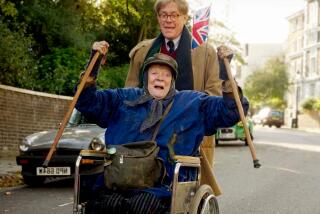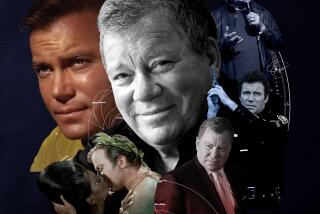She wasn’t common
- Share via
LIKE anyone with a passion for the golden age of Hollywood, when the studios actually made films for adults instead of only pretending to, I thought I knew all about Barbara Stanwyck. I was wrong.
I’d seen many of her dozens of features and been mightily impressed by her trifecta of knockout performances in “Stella Dallas,” “Double Indemnity” and “The Lady Eve.” But I still thought of the actress, may the gods forgive me, as a kind of second-tier star, not quite up there with one-name luminaries such as Hepburn, Davis and Garbo. It took a new UCLA Film & Television Archive series to set me straight.
“A Lady to Talk About: The Films of Barbara Stanwyck,” set to open Friday night at the Billy Wilder Theater in Westwood’s Hammer Museum, will showcase 18 of the films -- from 1931’s “Night Nurse” and “The Miracle Woman” through 1957’s Sam Fuller-directed “Forty Guns” -- that led to the old adage that Stanwyck was the best actress never to win an Oscar. She was that, and more.
The academy, which nominated Stanwyck four times and finally gave her an honorary Oscar in 1981, is making up for past sins with a centennial tribute Wednesday at 8 p.m. at its Samuel Goldwyn Theater in Beverly Hills. It is also hosting a vivid visual tribute to the star with a wide-ranging lobby exhibition of 70 Stanwyck posters from the collection of producer Mike Kaplan.
The UCLA series provided the occasion for a personal reevaluation of Stanwyck based on a concentrated dose of her films. To view big chunks of her work in a brief period of time is to both gain new respect for what might otherwise be taken for granted and to appreciate Stanwyck as easily the equal -- and sometimes the superior -- of any of the golden age big names.
Seeing Stanwyck’s films one after another also made me realize why she isn’t always as celebrated as her peers. For finally what made her so good -- her dazzling versatility, her willingness to be a team player and do what a given film demanded, her lack of stratospheric ego -- also kept her from ultimate stardom. With Stanwyck, it is frankly easy to underestimate the breadth and depth of what she is doing because of how easy she makes it seem.
What was not easy was Stanwyck’s early life. Born Ruby Stevens in 1907, she was orphaned by the time she was 4 and a chorus girl by 15. When she was 21, she married vaudeville headliner Frank Fay, a decade her senior, and went with him to Hollywood, but their careers went in such opposite directions that some sources claim the marriage was a model for the classic “A Star Is Born.”
Though the actress would say in later life that her foster home childhood wasn’t as grim as people assume, for whatever reason no one has ever played wised-up as convincingly on screen as Stanwyck. Just the idea of putting something over on one of her characters is unthinkable. When her Phyllis Dietrichson looks over at Fred MacMurray’s Walter Neff in “Double Indemnity” and drawls, “I think I know what you mean,” there is no doubt that she does.
One of the ultimate Stanwyck wised-up roles was 1933’s “Baby Face,” perhaps the most outrageous of pre-code melodramas, in which the actress plays Lily Powers, a.k.a. “the sweetheart of the night shift,” a young woman who complains to her father, with reason, “Ever since I was 14, it’s been men, dirty men.”
Persuaded by, no kidding, a Nietzsche-quoting cobbler to make better use of her power over the opposite sex, Lily moves to New York, where she sleeps her way to the top of a very tall office building. When a potential employer asks if she’s had any experience, her response -- “Plenty!” -- has as much truth as poetry in it.
BUT to see the actress as too exclusively hard-boiled is to fall into the Stanwyck trap, to assume that since she is so good at this, it’s what she does best. In fact, what is remarkable about Stanwyck’s variety is her ability to make each aspect of her persona seem as if it is quintessentially her.
This was never more true than in her Oscar-nominated performance (if there were any justice in Hollywood, she would have won) as the title character in the grandmother of all three-hanky movies, the 1937 version of “Stella Dallas.” Stanwyck’s Stella is a feisty striver who is so hungry for upward mobility she doesn’t see how she is hurting her own chances. She snags a rich man, can’t make the marriage work and instead focuses on her daughter’s prospects. What makes Stanwyck’s performance so affecting is that we always glimpse the innocent under Stella’s awkward, venal calculations. Her self-sacrifice, as it plays out in what has to be one of the great Hollywood denouements, is almost more than we can bear.
But just as we’ve gotten used to Stanwyck as the ultimate in anti-sophistication, along comes 1941’s “The Lady Eve,” a dazzlingly verbal Preston Sturges concoction in which her skill with dialogue and innuendo -- “See anything you like?” she asks a perpetually dumbfounded Henry Fonda, who’s just been up the Amazon for a year -- makes her character as delightfully self-aware as Stella Dallas is oblivious. To see this role is to feel that Stanwyck must have done nothing but glib romantic comedies her whole career, but in fact this is far from what she was known for.
And though her Jean Harrington is a crafty con woman (“Let us be crooked, but never common,” is her father’s motto), nothing about the lightness of Stanwyck’s “The Lady Eve” characterization prepares you for the icy determination and killer instincts of her Dietrichson role in “Double Indemnity,” written by Billy Wilder and Raymond Chandler from the novella by James M. Cain.
In fact, Stanwyck revealed in a documentary interview, it was Wilder who dismissed her fears of playing “an out-and-out cold-blooded killer. Mr. Wilder -- and rightly so -- looked at me and he said, ‘Well, are you a mouse or an actress?’ ” Despite some qualms about her blond wig -- a Paramount executive joked, “We hired Barbara Stanwyck and here we get George Washington” -- the actress turned in another impeccable performance.
If Stanwyck was a perfect fit for Wilder in “Double Indemnity,” she was just as good a match for Douglas Sirk in his deep-dish weepie “All I Desire,” for Anthony Mann in the offbeat western “The Furies,” even for Frank Capra’s ode to exotic Oriental erotica, “The Bitter Tea of General Yen.” No matter how strong-minded or idiosyncratic a director was, Stanwyck instinctively got with the program.
Yet despite these chameleon qualities, the triumph of Stanwyck’s career was that she remained indisputably and indestructibly herself throughout it all. The actress always burned brightly on screen, with a quality of aliveness that made her seem remarkably genuine no matter what the circumstances. What Capra noticed the first time he directed her in 1930 -- “Stanwyck doesn’t act a scene, she lives it” -- was a gift that never left her, a gift that enriches our movie lives to this day.
*
*
‘A Lady to Talk About: The Films of Barbara Stanwyck’
Where: Billy Wilder Theater, Hammer Museum, 10899 Wilshire Blvd., Los Angeles
When: Friday to June 10 at 7:30 p.m. unless otherwise noted
Price: $7 to $10
Contact: (310) 206-8013 or go to www.cinema.ucla.edu
Schedule
Friday: “The Bitter Tea of General Yen,” “Baby Face”
Next Sunday: “Ball of Fire,” “Meet John Doe,” at 7 p.m.
May 26: “Double Indemnity,” “The File on Thelma Jordon”
June 1: “Ladies They Talk About,” “The Lady Eve”
June 2: “All I Desire,” “There’s Always Tomorrow”
June 6: “Golden Boy,” “Stella Dallas”
June 8: “Night Nurse,” “The Miracle Woman”
June 9: “The Furies,” “Forty Guns”
June 10: “Sorry, Wrong Number,” “Clash by Night,” at 7 p.m.
More to Read
The biggest entertainment stories
Get our big stories about Hollywood, film, television, music, arts, culture and more right in your inbox as soon as they publish.
You may occasionally receive promotional content from the Los Angeles Times.











